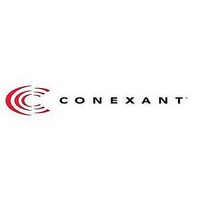cx82100 Conexant Systems, Inc., cx82100 Datasheet - Page 135

cx82100
Manufacturer Part Number
cx82100
Description
Home Network Processor Hnp
Manufacturer
Conexant Systems, Inc.
Datasheet
1.CX82100.pdf
(226 pages)
Available stocks
Company
Part Number
Manufacturer
Quantity
Price
Part Number:
cx82100-11
Manufacturer:
CONEXANT
Quantity:
20 000
Company:
Part Number:
cx82100-41
Manufacturer:
CONEXANT
Quantity:
179
Company:
Part Number:
cx82100-41
Manufacturer:
CONEXANT
Quantity:
16
Part Number:
cx82100-41
Manufacturer:
CONEXANT
Quantity:
20 000
Company:
Part Number:
cx82100-41Z
Manufacturer:
CONEXANT
Quantity:
28
Part Number:
cx82100-41Z
Manufacturer:
CONEXANT
Quantity:
20 000
Company:
Part Number:
cx82100-51
Manufacturer:
CONEXANT
Quantity:
12
8
101306C
USB Interface Description
Conexant Proprietary and Confidential Information
The USB Interface (or UDC Core) consists of three major functions: USB Controller
(USBC), APB/DMA Interface (I/F), and USB Differential Transceiver (Figure 8-1). The
USBC includes the following functions:
•
•
•
•
Phase Locked Loop (PLL) Block. The PLL Block extracts the USB clock and data
from the USB cable. The input to the PLL Block comes from an USB Differential
Transceiver. The PLL runs on a 48 MHz clock. The PLL also generates a 12 MHz
clock from the 48 MHz clock and supplies it to the Serial Interface Engine (SIE) and
USB Bridge Layer (UBL) blocks. The PLL identifies the Single Ended Zero (SE0)
signal on the USB and sends it to the SIE Block.
Serial Interface Engine (SIE) Block. The SIE Block performs the front end
functions of the USB protocol such as SyncField identification, NRZI-NRZ
conversion, token packet decoding, bit stripping, bit stuffing, NRZ-NRZI
conversion, CRC5 checking, and CRC16 generation and checking. The SIE also
converts the serial packet to 8-bit parallel data. The SIE Block has a 1-byte buffer for
buffering the data during data transmission and reception.
USB Bridge Layer (UBL) Block. The UBL Block handles the error recovery
mechanism during transactions while interfacing to the Application (the Application
includes the APB/DMA I/F, the ARM940T Processor, and the ARM firmware
processing the data). The UBL also decodes and handles all the Standard Control
Transfers addressed to Endpoint Zero. The UBL passes some USB commands onto
the APB/DMA I/F so that the Application can decode and process the command. The
UBL Block has two sub-blocks called the Protocol Layer (PL) Block and the
Endpoint (EP) Block.
The PL Block controls the SIE Block by providing necessary handshake signals to
the SIE and communicates with the APB/DMA I/F. It also performs error recovery if
the APB/DMA I/F violates the data transfer protocol.
The EP Block handles all the Control transfers to Endpoint Zero. The EP Block
decodes and responds to all the USB Standard Commands and some other USB
Commands (e.g., Get Descriptor) to the APB/DMA I/F. The EP Block maintains the
buffer for Device Address, buffer for storing the present active Configuration, and
the logic to determine the present state of the Device (USBC).
Endpoint Information (EPINFO) Block: The EPINFO maintains the registers that
store information about the endpoints. The EPINFO also stores the information about
the size of Configuration in the USBC. The information about the current endpoint is
multiplexed from these registers and is provided to the PL Block which controls the
SIE Block based on this information. The EPINFO also includes the
DATA0/DATA1 synchronization bits for each bidirectional endpoint the USBC
supports. Also, the EPINFO includes the EndPtStalled bit for each of the supported
logical endpoints to indicate the Stalled Status of the Endpoint. The HNP EPINFO
supports up to 3 active bidirectional logical endpoints and one interrupt endpoint.
The endpoint number ranges from 0 to 4.
CX82100 Home Network Processor Data Sheet
8-1












